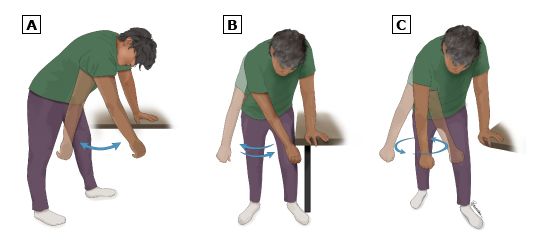Pendulum-swing Exercise for the Shoulder
About this exercise
Before trying this exercise, talk with your healthcare provider about any challenges you have with bending over, like back pain or dizziness.
This exercise should not increase your pain. If it does, stop the exercise and talk with your healthcare provider.
Do the pendulum-swing exercise 2 to 3 times each day even while your shoulder is still tender from an injury or surgery. Doing the exercise after each meal can help you remember how often to do it.
To do the pendulum-swing exercise for your shoulder:
- While holding onto a table or the back of a chair with your good arm, bend forward a little and let your injured arm hang straight down. You may be more comfortable if you bend your knees and place one foot slightly in front of the other. This will be easier on your back and hips and will help you use your body to start the arm movement.
- Relax your arm and shoulders as much as possible.
- Use your legs and your hips to create movement that makes your arm swing freely. This exercise does not use the arm muscles.
- Using the momentum from your hips and legs, guide your slightly swinging arm back and forth like a pendulum (or elephant trunk), then in circles that start small (about the size of a dinner plate). Make the circles larger each day, as your pain allows.
- Do each movement 10 times: move your arm back and forth 10 times, then swing it side to side 10 times, then do 10 clockwise circles, then do 10 counterclockwise circles. Take a short rest if needed and repeat.
As you have less pain, try bending over a little farther to do this exercise. This will increase the amount of movement at your shoulder.

From Lexicomp and UpToDate Patient Handouts: Separated Shoulder, by Lippincott Advisor, 2024.
Copyright 2024 by UpToDate, Inc.
To see this information online and learn more, visit MyHealth.Alberta.ca/health/aftercareinformation/pages/conditions.aspx?hwid=custom.ab_pendulum_swing_shoulder_exer_inst.

For 24/7 nurse advice and general health information call Health Link at 811.
Current as of: October 17, 2024
Author: Allied Health (Physiotherapy), Alberta Health Services
This material is not a substitute for the advice of a qualified health professional. This material is intended for general information only and is provided on an "as is", "where is" basis. Although reasonable efforts were made to confirm the accuracy of the information, Alberta Health Services does not make any representation or warranty, express, implied or statutory, as to the accuracy, reliability, completeness, applicability or fitness for a particular purpose of such information. Alberta Health Services expressly disclaims all liability for the use of these materials, and for any claims, actions, demands or suits arising from such use.
